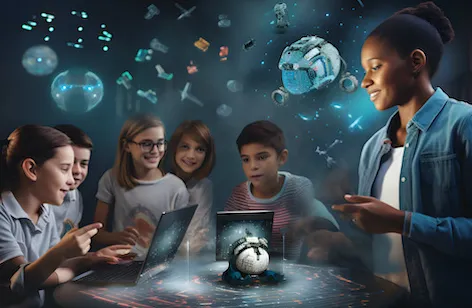The integration of technology in education has been transforming the way we teach and learn for over two decades. As we move deeper into the 21st century, the advancements in technological tools and platforms are reshaping not only the methods of delivery but also the very structure of education itself. In 2024, the role of technology in shaping the future of education is more prominent than ever, with trends emerging that promise to redefine the learning experience for both students and educators. From artificial intelligence (AI) to immersive learning experiences and adaptive learning platforms, the educational landscape is evolving rapidly. This article explores the major technological trends that are expected to shape the future of education in 2024 and beyond.
1. Artificial Intelligence (AI) in Personalized Learning
One of the most transformative forces in education today is the rise of Artificial Intelligence. In 2024, AI is poised to play a significant role in personalizing learning experiences for students. Traditionally, classrooms have operated under a one-size-fits-all approach, but AI can now tailor educational content to each student’s individual needs, learning style, and pace.
AI-powered platforms can analyze student performance in real time, identifying areas where students are excelling and others where they might need more support. Adaptive learning technologies, driven by AI, can dynamically adjust the difficulty level of lessons, provide instant feedback, and offer personalized recommendations for improvement. For example, AI tutoring systems, such as chatbots and virtual assistants, can provide immediate support to students, helping them with assignments, answering questions, and even offering additional resources to reinforce learning.
Moreover, AI can assist educators by automating administrative tasks, such as grading and assessment, which allows teachers to dedicate more time to instruction and student engagement. By 2024, AI-driven educational tools will become increasingly sophisticated, offering a more individualized learning experience that empowers both students and educators.
2. Virtual and Augmented Reality (VR/AR) for Immersive Learning
Virtual Reality (VR) and Augmented Reality (AR) have been gaining traction in education for several years, and by 2024, their impact is expected to be even more profound. These technologies offer immersive learning experiences that engage students in ways that traditional methods cannot.
In a VR-enabled classroom, students can explore historical sites, conduct scientific experiments, or even walk through the human body—all from the safety and convenience of their classroom or home. AR, on the other hand, can overlay digital content onto the physical world, enhancing the learning process with interactive elements. For example, students could use AR to see 3D models of the solar system or interact with a virtual museum exhibit.
The key benefit of VR and AR in education is their ability to bring abstract or complex concepts to life. Visualizing subjects like anatomy, chemistry, or physics can help students grasp difficult concepts more effectively, while enhancing their engagement and retention. In 2024, we expect to see these technologies become more widely adopted, with schools, universities, and training centers integrating them into curricula to provide richer, more dynamic learning experiences.
3. The Rise of EdTech Platforms and Online Learning
The COVID-19 pandemic accelerated the adoption of online learning, and this shift is continuing into 2024. With the growing demand for flexible learning environments, EdTech platforms are evolving to meet the needs of a global student body. Online learning is no longer just a response to a crisis but is becoming a permanent feature of the educational landscape.
Platforms like Coursera, Udemy, and Khan Academy offer massive open online courses (MOOCs) that allow students to access high-quality education from anywhere in the world. In 2024, these platforms will continue to expand their offerings, incorporating more interactive features, certifications, and even real-world applications of learning. The ability to earn credentials online is democratizing access to education, allowing people from all walks of life to upskill, reskill, or pursue their educational goals without the traditional barriers of location, cost, or time constraints.
Furthermore, hybrid learning models, combining in-person and online education, will become more common in 2024. This approach allows for more flexible and personalized learning experiences, with students able to access lectures, discussions, and materials online while participating in hands-on activities or group projects in person.
4. Blockchain Technology for Credentials and Data Security
Blockchain technology, known for its role in cryptocurrency, is beginning to make waves in education, particularly in the areas of credentials and data security. By 2024, we will likely see a more widespread use of blockchain to verify and store educational credentials, making them tamper-proof and easily transferable across institutions and borders.
Blockchain can provide a secure, immutable record of a student’s achievements, including grades, certificates, and even extracurricular activities. This could revolutionize the way degrees and diplomas are issued, reducing the risk of fraud and allowing employers and institutions to verify credentials with greater ease. Additionally, blockchain’s decentralized nature ensures that students’ data is more secure, protecting it from breaches and unauthorized access.
5. The Growth of Gamification in Education
Gamification, or the integration of game mechanics and principles into non-game contexts, has already seen success in education, and by 2024, it is expected to grow exponentially. Through the use of points, badges, leaderboards, and challenges, gamification motivates students to engage with content in a more dynamic way, turning learning into an interactive and rewarding experience.
In 2024, educational games will become more sophisticated, incorporating advanced AI and VR technologies to create more immersive learning experiences. For example, students may be able to participate in virtual simulations of historical events or conduct science experiments in a virtual lab, all while earning rewards and progressing through levels. This approach can enhance motivation, foster collaboration, and improve retention by making learning fun and interactive.
6. 5G Connectivity and Its Impact on Education
The rollout of 5G technology in 2024 will have a significant impact on the education sector, particularly in terms of connectivity. With higher speeds, lower latency, and the ability to connect a larger number of devices simultaneously, 5G will enable real-time, high-quality streaming of lessons, interactive content, and virtual learning environments.
The increased connectivity provided by 5G will make it easier for remote learners to access live, interactive lessons without interruptions. It will also allow for the seamless integration of IoT (Internet of Things) devices in classrooms, where smart boards, sensors, and other connected tools can enhance the learning experience. In rural or underserved areas, 5G could bridge the digital divide, enabling more equitable access to educational resources and opportunities.
7. Data Analytics and Learning Insights
Data analytics is becoming an integral part of education, allowing educators and administrators to make more informed decisions about teaching and learning strategies. By 2024, educational institutions will increasingly rely on data-driven insights to track student progress, identify trends, and tailor interventions more effectively.
Learning analytics tools can aggregate data from multiple sources, such as assessments, attendance, and behavior, to provide a comprehensive view of each student’s learning journey. These insights can help educators spot early signs of disengagement or academic struggle, allowing them to intervene before students fall behind. In addition, data can be used to improve the curriculum itself, ensuring that content is relevant and effective for students.
Conclusion
The future of education is undoubtedly shaped by the rapid advancements in technology. As we move into 2024, the educational landscape is set to undergo a major transformation, with AI, VR/AR, EdTech platforms, blockchain, gamification, 5G, and data analytics leading the charge. These technologies are not only improving how education is delivered but are also democratizing access to learning, making it more personalized, engaging, and effective.
For educators, students, and institutions, staying ahead of these trends is essential to ensuring that the future of education is inclusive, dynamic, and prepares learners for success in an increasingly technology-driven world. As we embrace these innovations, the possibilities for shaping the future of education are endless.



